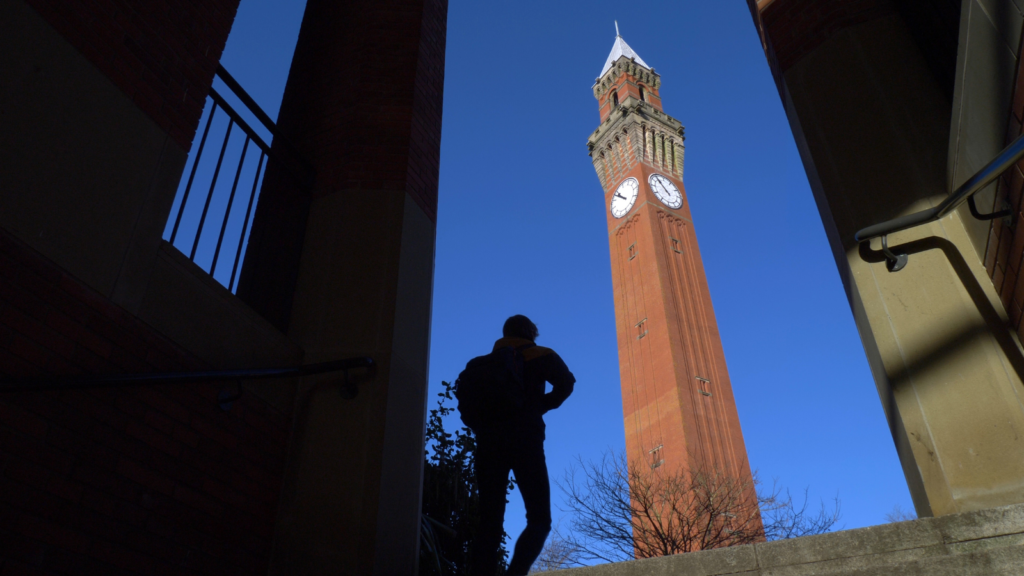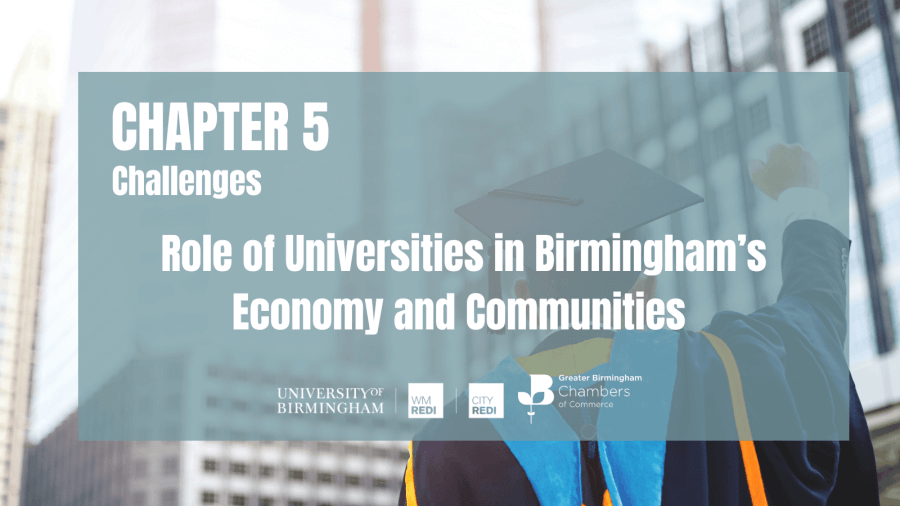Sara Hassan and Hannes Read discuss how universities in Birmingham can act as anchors and civic institutions for the benefit of the city-region.
This article was written for the Birmingham Economic Review.
The review is produced by City-REDI / WMREDI, the University of Birmingham and the Greater Birmingham Chambers of Commerce. It is an in-depth exploration of the economy of England’s second city and a high-quality resource for informing research, policy and investment decisions.
Anchor Institutions
Higher Education institutions are widely recognised as important actors in the local economy through local spending, and local recruitment, in addition to increasing the local level of human capital.
Anchor institutions are large public-sector organisations (hospitals, councils, universities, housing associations) that are unlikely to relocate. They are effectively ‘anchored’ in their surrounding community and have assets, such as spending power, employment and training, and buildings and land, that can be used to build wealth and economic development in their communities. An anchor institution that uses its assets to support the communities in which it operates can affect the economic growth and development of a local area in a significant, inclusive, and positive way. This promotes a more circular economy approach that is more tied up in place. Anchor institutions are invested in strong relationships with their customers, employees, and community.
The Impact of Universities in Birmingham
In Birmingham, universities can have a significant impact on the local economy. The five universities – University of Birmingham, Birmingham City University, Aston University, University College Birmingham and Newman University– employ around 15,000 staff and teach around 90,000 students. For comparison, six of Birmingham’s most famous employers – Lloyds Bank, Cadbury’s (Mondolez International), Jaguar Land Rover, Rolls-Royce, Aston Villa FC and Birmingham City FC – employ around 10,000 people in the city. With universities employing around 50% more people than some of the most famous companies in the city, there is significant potential for universities to make a substantial difference in the local economy.

Engagement with the local economy and communities
Universities across Birmingham have strong examples of their engagement in the local economy and communities. They all contribute well to the seven domains of civic impact, identified by the Civic University Network, in which universities can make a difference in their localities (Figure 1).
The £4.5m invested at STEAM house by Birmingham City University has renovated the disused Belmont Works and supported the regeneration of Birmingham’s Eastside. The Moss House campus at University College Birmingham brings together teaching and learning in health and wellbeing through cutting-edge sports science clinics and replica community care environments. The University of Birmingham has a wide array of cultural assets such as Winterbourne House and Botanical Gardens, Lapworth Museum of Geology and Barber Institute of Fine Arts. All five universities in Birmingham have signed a Civic University Agreement with Birmingham City Council which identifies a joint approach to enhancing their role in the local community.
Seven domains of civic impact as identified by the Civic University Network.

Civic Impact: Metrics, Data and Practice
While universities seem to be committing to making a difference in their localities and the city. There are limited studies that measure and highlight the full extent of the economic, social and environmental impacts. In Birmingham, universities such as the University of Birmingham, Birmingham City University and University College Birmingham, have publicly produced economic impact assessments in an attempt to measure their economic impact. However, it can be argued that these published reports do not portray either the overall impact of the university or an in-depth detail of this impact locally. Rather, third-party evaluators focus on normative elements of economic impact, such as case study examples. These fail to capture the overall processes of university operations. For example, one economic impact assessment states that bringing in eight undergraduate international students would contribute £1 million to the UK economy. Critically, there is little recognition of the impact that has at a sub-national or even a local scale.

Recently, universities have been more focused on diversity and inclusion. Another challenge to the economic impact assessments is capturing these efforts. For example, key issues such as encouraging people from areas with lower levels of higher education enrolment to study in Birmingham do not feature in the economic impact assessment. However, this type of targeted enrolment to underrepresented student groups can increase graduate earnings by around £5000 per year. It is noteworthy that many of these university contributions can be overlooked although they do produce an economic and social impact. The gap in measuring these sorts of contributions can be detrimental particularly when universities are striving to increase their impact and affect positive change in communities across the city. The lack of data and information on the impact on communities at a sub-national scale shows that universities are under-selling themselves when evidencing their impact.
The Civic Index, created by WMREDI, brings together data on economic, environmental, institutional, and social impacts to show the difference that higher education institutions make to their local area. For instance, the Civic Index data show that Birmingham City University (BCU) is a leader in the field of carbon reduction. These findings not only support BCU’s collaborative efforts in reducing carbon emissions with other universities but can also affect the city’s efforts in the race for carbon neutrality. However, whilst this sort of data sheds light on the impact that universities make, there is a need to understand how these practices can be embedded with practical civic engagement.
Universities in the UK are then under increasing pressure to demonstrate the practical impacts of their research, teaching and knowledge transfer. Relatively less attention is paid to the role of universities in building social connections with their local areas and empowering marginalised communities through active civic engagement strategies. For example, Universities in Birmingham are key stakeholders in innovation and knowledge generation. They are producers and consumers of creative talent and developers of place trends. However, place-based investments do not happen in isolation, with innovation, knowledge, and the “creative class” as forces driving urban revitalisation. In addition, this highlights concerns that without a more local and even neighbourhood focus from universities as anchor institutions, this can lead to gentrification in their immediate local areas.
Further challenges in research and practice
One of the challenges that face both research and university operations in practice is the need to map and connect different parts of university operations (research, teaching, professional services) to enable true anchoring. Another challenge is institutional cultural change where civically minded institutions acknowledge and undertake their multifaceted role in the inclusive and sustainable development of cities. Most of normal university operations are largely overseen by professional service staff in estates, HR, finance and procurement. For example, in Birmingham, the Birmingham Anchor Network have a long-standing relationship with Aston University, University of Birmingham, Birmingham City Council, University Hospitals Birmingham, Bournville Village Trust, and The Pioneer Group to circulate and maximise the impact of their employment, procurement spend and physical assets for the local economy. The Birmingham Anchor Network and Civic University Network, of which the University of Birmingham and Aston University are members, are examples of how the business models and operations of universities have changed towards one that makes a purposeful difference in the local economy. This underpins the growing interest in the role of universities as a civic institution.
Knowledge transfer and sharing of evidence, evaluation, and good practice will transform universities from anchor institutions that are based in Birmingham, to ones that are fully and truly embedded in improving outcomes for residents in the city. At WMREDI, we are working on the National Civic Impact Accelerator programme to share the evidence and good practice for improving the civic impact of universities.
This blog was written by Dr Sara Hassan, Research Fellow and Hannes Read, Policy and Data Analyst, University of Birmingham.
Disclaimer:
The views expressed in this analysis post are those of the authors and not necessarily those of City-REDI / WMREDI or the University of Birmingham.

